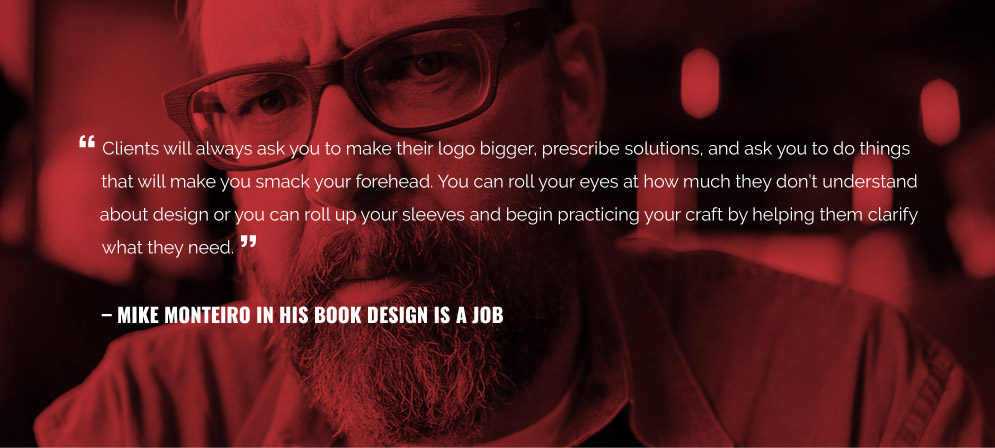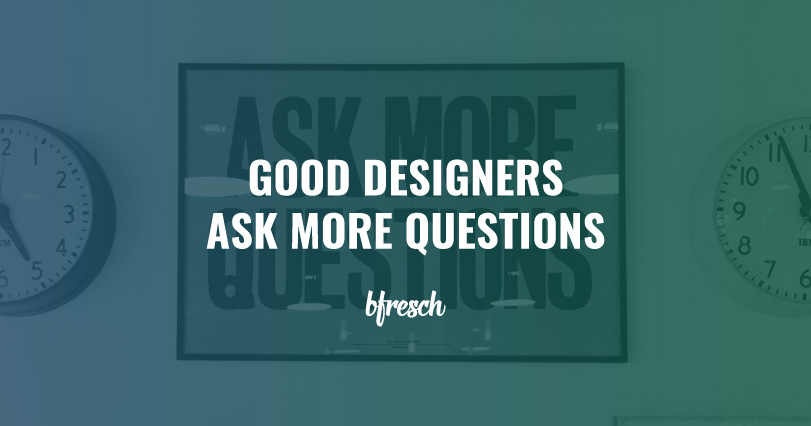You just gained a new client, after introductions happen in the client kickoff meeting problems to be solved spill out of the client’s mouth. These are problems that you as the designer are tasked to solve. If you take notes most of the meeting and don’t ask questions, finding a solution is more difficult. A good designer asks good questions, especially at the very beginning of the process.
Understand this, your clients are the experts in their business but are not experts in the valuable solutions you can provide through strategic design. Sometimes it can feel like clients are just looking for a designer to just execute and make something that looks nice. You’re wrong, they’re coming to you for your consultative expertise and you must deliver measurable results but you can’t start the process of doing that without asking good questions first.

Understand the goals of the project
First, you need to understand the purpose the client is trying to accomplish on their website. What is the main goal? Is there a secondary goal? How are those goals being met currently on the website? Do they have a clear hierarchy to them or are they split focused?
To learn where you stand, start by asking your client these questions:
- What is the single most important thing users can do on your website?
- How are you currently engaging with your audience? Have you received any feedback from people describing the frustrations they are currently having?
- What is your main call-to-action on your website? Does it match up with the main goal?
- When people think about your brand ideally what does that look like?
- What value do people receive from your brand when visiting your website other than buying a product or signing up for a service?
Separate the client from the target audience
Even if the client is great at describing their taste and preferences in design it is very likely that they are not the end user. This is where good designers become great designers you need to develop a way to tactfully say, “No.” Always give an educated results based explanation as to why you’re approach will be better for them than their alternative solution.
At this point, you can approach user testing research with your client as an additional service. User testing research is a great way to learn the behaviors of people that would actually be interested in using the website. You can set up a test around the client’s problem with custom tasks that you define for users to go through. The tool I use to do this can be found at usertesting.com.
Some questions that focus on the user’s experience include:
- What is the mindset of the user’s when to come to your website?
- What problem is the user having that this website will solve? How can do they order or contact you for your products or services currently? Can that be easier to do?
- Are they coming to this website to get information? What specific information are they looking for? Can they find it easily?
- What is the current brand perception your users are receiving from your website? How can it be adjusted to achieve the client’s perception goals?
- What is the single most important thing users are looking for on this website? How can the design adjust to that main call-to-action on all internal pages?
PRO TIP: As a designer, you have the right to push back on a client two times when they ask for something you disagree with. When this happens to me I like to give my professional expertise first. If they still don’t bite after I explain my reasoning I turn to Google Surveys or A/B testing to prove it to them. If they are still persistent about their idea I let it go and design other solutions around it.
It’s your responsibility as a designer to give your expertise for the best results possible. As a professional, it’s your responsibility to respect your client’s decision at the end of the day.
You must start by asking questions
Everything design begins with questions, the quality of your questions will increase after you learn the answers to these general questions. My hope for this post was to help kick start your questionnaire process. If you think you’re going to run out of questions to ask, don’t. More times than not answers breed more questions, keep asking them because it will contribute to a better product for your client in the end.
You may be an expert designer but respect that you most likely are not an expert in your client’s industry. Communicate and collaborate with your client, let them display their expertise to you, stay humble and together you’ll reach the best solution possible.
[divider line_type=”Full Width Line” custom_height=”20″]
[recent_posts title_labels=”true” category=”all”]

